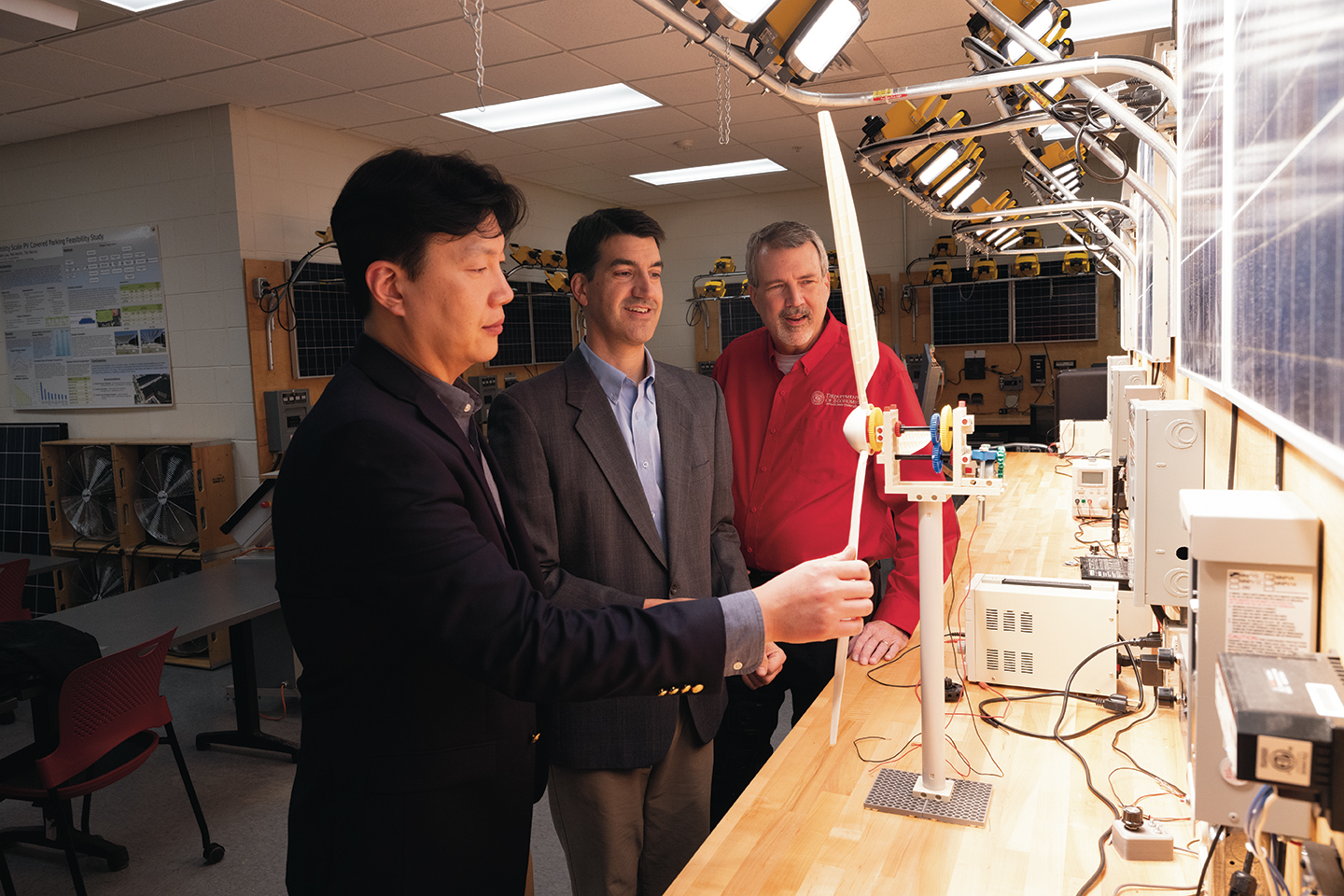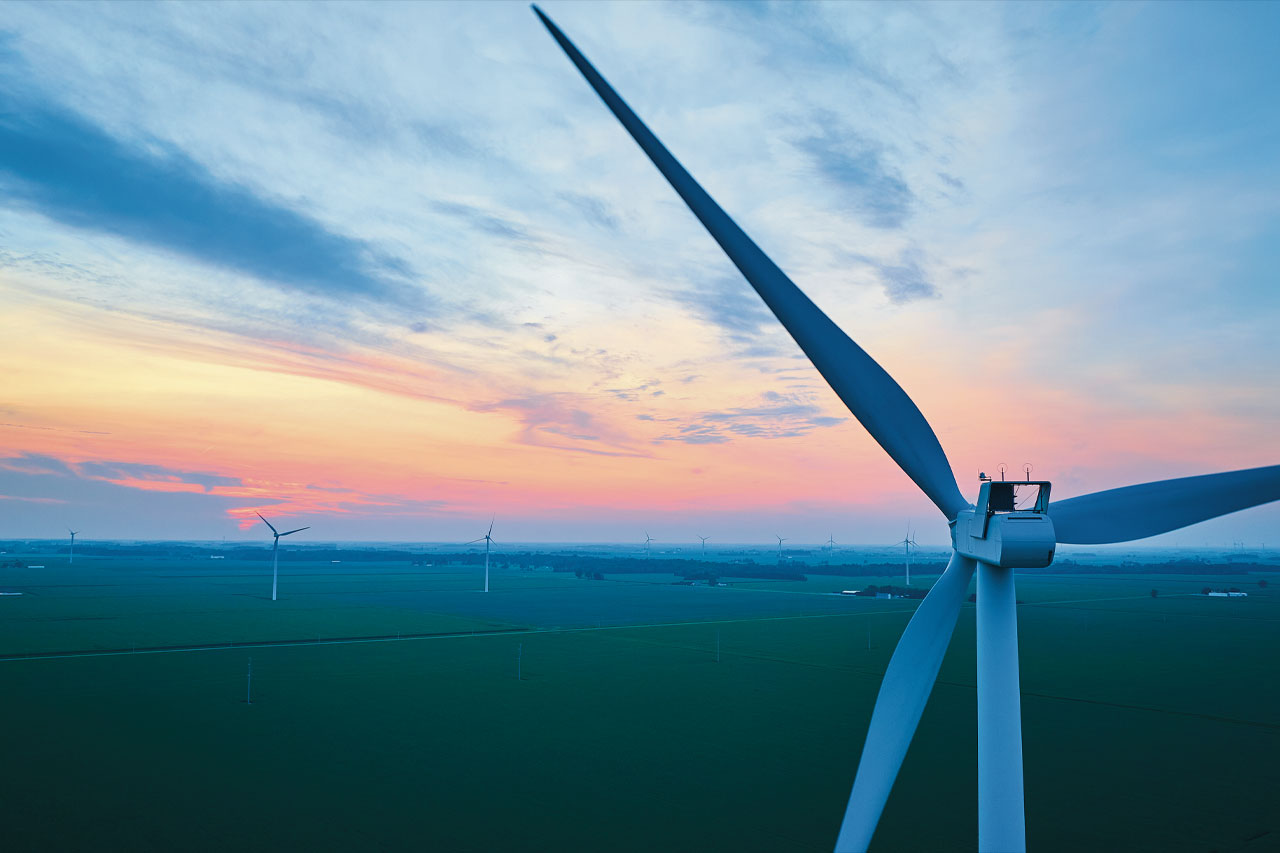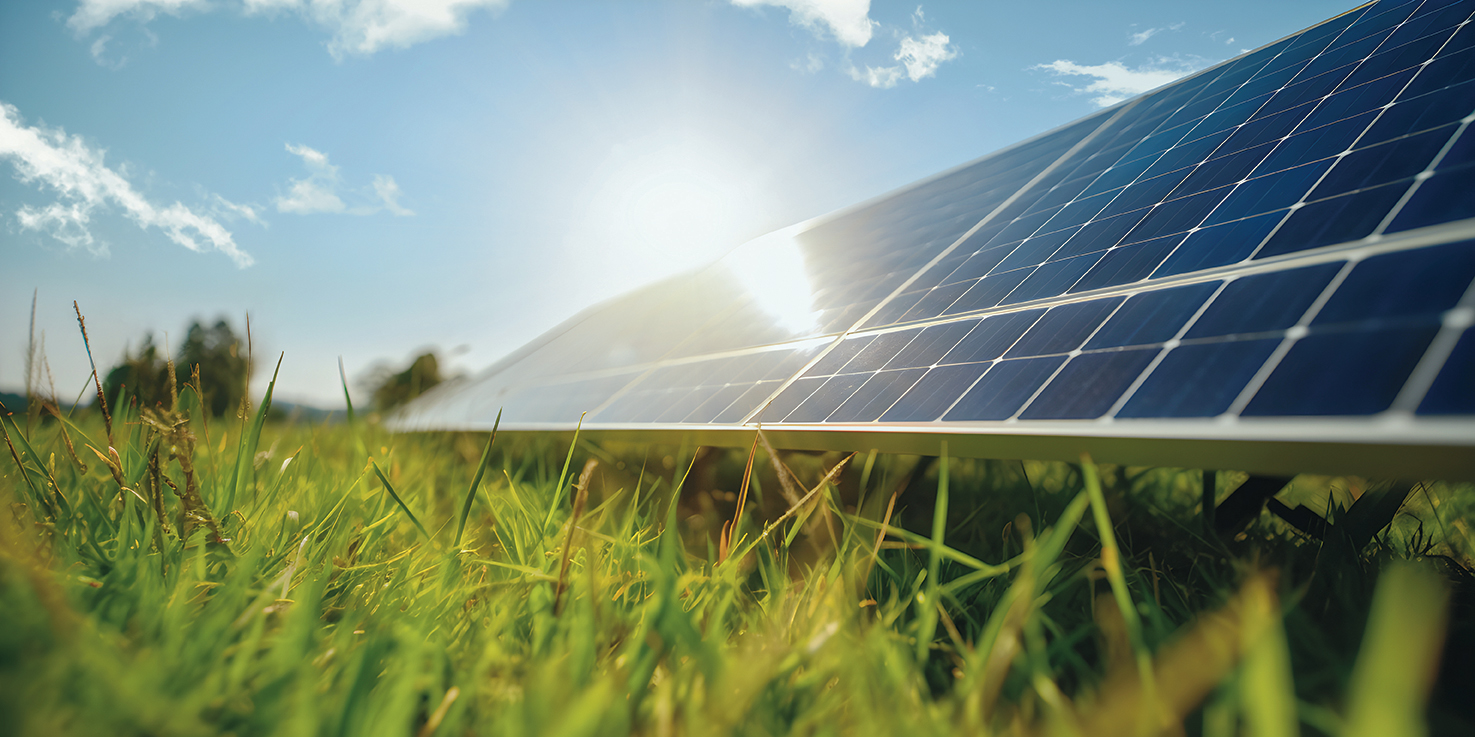During 10-hour road trips to visit family in the early 2000s, Dr. David Loomis almost always exited the Pennsylvania Turnpike in Somerset County to admire six, 200-foot-tall wind turbines quietly spinning atop a picturesque ridgeline.
His kids tolerated the detour because they got ice cream from a shop at the onlooking rest area.
Appears In“Every time I would take pictures of these wind turbines and think, isn’t this fascinating?” said Loomis, a professor emeritus of economics at Illinois State University. “We’re generating electricity from just the wind and these spinning blades.”
Loomis dreamed of erecting what would have been one of the first wind turbines in Illinois at the University Farm in Lexington. But novel wind technology was cost-prohibitive.
He didn’t expect that just a few years later, electricity-generating wind turbines would become common along Illinois’ rural horizons.
Rapid growth
In 2003, the state’s first wind farm, Mendota Hills, was constructed in Northern Illinois. And in 2008, Illinois’ largest wind farm, Twin Groves I and II (240 turbines capable of producing 396 megawatts), came online in McLean County, 17 miles east of Illinois State’s campus.
Just 20 years after Mendota Hills began generating electricity, Illinois skyrocketed to fifth nationally in wind production, with about 7,000 megawatts of capacity—enough to power close to 2 million homes annually, according to a 2022 analysis by the U.S. Energy Information Administration.
Driven by the development of more than 20 utility-scale wind farms, in-state electricity from renewable energy has more than tripled over the past decade, and it is expected to continue growing in Illinois as new solar and wind projects join the electric grid.
Loomis and Department of Technology colleagues Dr. Matt Aldeman and Dr. Jin Jo have become statewide leaders in advancing renewable energy.
Last fall, they hosted the two-day Illinois Renewable Energy Conference in Normal featuring 35 speakers with diverse areas of expertise including workforce training, policy, and technology. Aldeman, Jo, and Loomis agree that Illinois has positioned itself near the forefront of renewable energy development.
Going green
In 2008, Loomis established the Center for Renewable Energy, which operated at Illinois State for the next decade and focused on the technical potential and economic benefits of renewable energy integration into the U.S. electric grid. Connected by the center, Aldeman, Jo, and Loomis began collaborating and were recognized with the Outstanding Cross-Disciplinary Team Research Award in 2016.
The trio jointly conducted a series of renewable energy integration studies that explored the potential of solar and wind energy generation within Illinois and focused on alternative energy storage on the electric grid. Their research has been published in dozens of peer-reviewed journals with international readership and led to speaking engagements across the world.
Aldeman, Jo, and Loomis also established the first interdisciplinary renewable energy major in the U.S. Housed in the College of Applied Science and Technology (CAST), the sustainable and renewable energy major is currently preparing about 25 students to address social, economic, and technical sustainability issues.
“Most of the students in this program are interested in energy, interested in making things work, and interested in making a positive difference in the world and society,” Aldeman said. “The great news for people graduating from our program is that jobs are plentiful.”
In 2022, Illinois’ clean energy workforce grew by 3% and is expected to increase more soon, according to the nonpartisan Environmental Entrepreneurs (E2) group. Nationally, employment of wind turbine service technicians is projected to grow by nearly 45%, faster than any other career, over the next 10 years.
Economically, Loomis said it makes sense for energy companies to invest in renewable technology.

Economic benefits
Although electricity-generating wind and solar power technology has existed for decades, large-scale projects weren’t economically viable until recently. Now, harnessing wind energy is the most affordable way to generate a kilowatt of electricity in the U.S.
“Over the past 10 or 15 years, wind energy costs have decreased as technology has improved. And there are economies of scale such that if you put up 50 or more wind turbines, you can really benefit in terms of those costs,” Loomis said. Now retired from Illinois State, he serves as an economic consultant for renewable energy projects across the U.S.
Loomis said wind installations are also strong economic engines for local economies. Illinois law requires energy companies to be taxed a standardized rate based on the megawatts of electricity that their installations can produce.
“The size and scale of these projects are such that the economic development value is unrivaled to anything else for a small, rural county,” Loomis said. “We’ve done a couple studies on property taxes that are paid by wind and solar in Illinois, and the benefits that have flowed to school districts as the primary taxing body, and to the counties and townships—these are very tangible, quantifiable benefits that flow to the community.”
Additionally, Loomis notes the impact these projects have by hiring construction workers, operation technicians, and site managers. Farmers also generate new income by renting their land for wind turbines or solar panels.
“We’ve found many cases where people say, ‘It helped save the family farm. This rent check goes to pay the property taxes or the feed bill or the fertilizer bill for next year,’” Loomis said. “It’s making a huge difference to those farming families.”
Loomis attributes the low cost of generating electricity from free fuel sources such as the wind or sun to the sustained growth of renewables in the energy marketplace over the past 10 years. In 2022, renewable generation surpassed coal and nuclear in the U.S. for the first time.
Illinois’ Renewable Portfolio Standard (RPS) has also incentivized clean energy by mandating that electricity suppliers provide customers with a stated minimum share of electricity from renewable resources.
Technological advances
When it comes to utility-scale wind farms, bigger is typically better, according to Aldeman. In recent years, engineers have created taller wind turbines with longer blades that catch higher wind speeds at an increased altitude. Advances in photovoltaic technology have simultaneously improved solar panel efficiencies.
“Most of the new solar cells that are on the market right now are somewhere in the 19% to 23% efficiency range, and that’s a lot higher than it was even 10 years ago,” Aldeman said. He noted the theoretical efficiency maximum is 34%.
“The fact that the fuel is free definitely should affect our view on efficiency because you’re getting power output and you’re not paying for the fuel,” Aldeman said. “The fuel is the photons that are coming in or the wind molecules of air that are moving and impacting the wind turbine blades.”
Manufacturing innovations have led to more efficient, less expensive renewable energy technology. Researchers are also working to make the technology more sustainable. Wind turbine blades, for example, are currently made of fiberglass, which is difficult to recycle. However, researchers are building prototypes of fully recyclable blades for future projects.
“That’s a really hot area of research right now,” Aldeman said.

Grid modernization
With the percentage of energy generated by renewables on the rise, Aldeman and Jo are researching ways to modify the U.S. electric grid to accommodate variable, nondispatchable energy sources such as wind and solar that are reliant upon the weather. This is a shift from traditional, dispatchable energy sources, such as coal-fired plants, which produce generally consistent levels of energy.
“You can do a lot by connecting electric grids across a really large area,” Aldeman said. “So, there’s a decent probability that if it’s not windy in Illinois right now, maybe it is windy in South Dakota or Ohio. Diversification of geography helps a lot.”
Aldeman said the U.S. also needs to increase its energy storage capacity, which is “almost negligible” currently.
“There is an energy revolution going on right now with renewable resources and distributed energy,” Aldeman said. “We’re gradually moving away from the centralized power plant that became very popular in the late 1800s/early 1900s, and we are gradually moving to decentralized distributed renewable generation.”
Scaling down to power up
As large, utility-scale project development continues, Jo sees residential and commercial renewable energy installations as important pieces to the energy puzzle.
“We have to develop at different scales,” Jo said. “We have to make the system economically viable. Otherwise, there will be a very low motivation.”
Jo is researching how to optimize energy management systems for commercial buildings. “They’re going to have their solar system in place in combination with the energy storage system and electric charging stations for their employees,” Jo said. “It’s a comprehensive energy solution.”
He said Illinois has proved to be a strong location for commercial and residential installations.
“A lot of solar and wind companies are moving into the state of Illinois, because of the more favorable market conditions through which they can grow faster than having their business in other states,” Jo said.
A combination of improved technology, an increasing economic upside, and clean energy policy have powered the growing renewable energy industry in recent years. When considering the effects of human-caused climate change, Jo said energy production presents the “most critical” problem.
“I find energy to be a resolution to all other sustainability-related problems—water, population resources, environmental problems, and many others. Renewable energy is going to be the most impactful solution to all the problems.”
Despite the seemingly monumental challenge, Jo remains optimistic.
“Throughout history, we have a record of making things better,” Jo said. “We were dealing with ozone depletion in the 1980s and 1990s, and many countries banned the usage of freon gas. By taking action, we were able to replenish the ozone layer. That’s just one example.
“We all need to be on the same page.”
Inspiring the next generation
Dozens of high school students in Chicago are exploring renewable energy, sustainability, robotics, and automation through after-school projects facilitated by Illinois State University faculty and students.
A four-year, $1.3 million grant from the National Science Foundation is funding Illinois State’s SUPERCHARGE (STEM-based University Pathway Encouraging Relationships with Chicago High Schools in Automation, Robotics and Green Energy) program through the 2025-26 school year.
“We’re working with four high schools in the Chicago area, and we’re developing after-school STEM clubs in those four areas (science, technology, engineering, and math) with the intention of creating really engaging and fun activities,” said Dr. Matt Aldeman, an associate professor of technology and one of the program’s principal investigators. “It’s not meant to be just another hour tacked onto the day.”
Students are using small, programmable single-board computers for their projects. Throughout the school year, they are designing and building a smart weather station, a solar tracking device, and an all-terrain electric scooter.
“The computers are pretty powerful, and you can do all kinds of programming with them,” Aldeman said. “And you can attach output devices to them and control other devices with them. They’re pretty fun to work with.”
Nearly 50 SUPERCHARGE students visited Illinois State’s campus last fall. They toured the Robotics Lab and the Renewable Energy Lab in Turner Hall, they heard from alum Sara Keene ’19, a launch service advisor with electric vehicle manufacturer Rivian, and they received information (and Redbird gear) from the Office of Admissions.
“We want the students to experience life on a college campus studying STEM, because that’s what we’re trying to encourage them to do,” Aldeman said. “STEM provides great career opportunities that are high paying and plentiful. So, I want all students to feel like they can succeed in a STEM field.”


